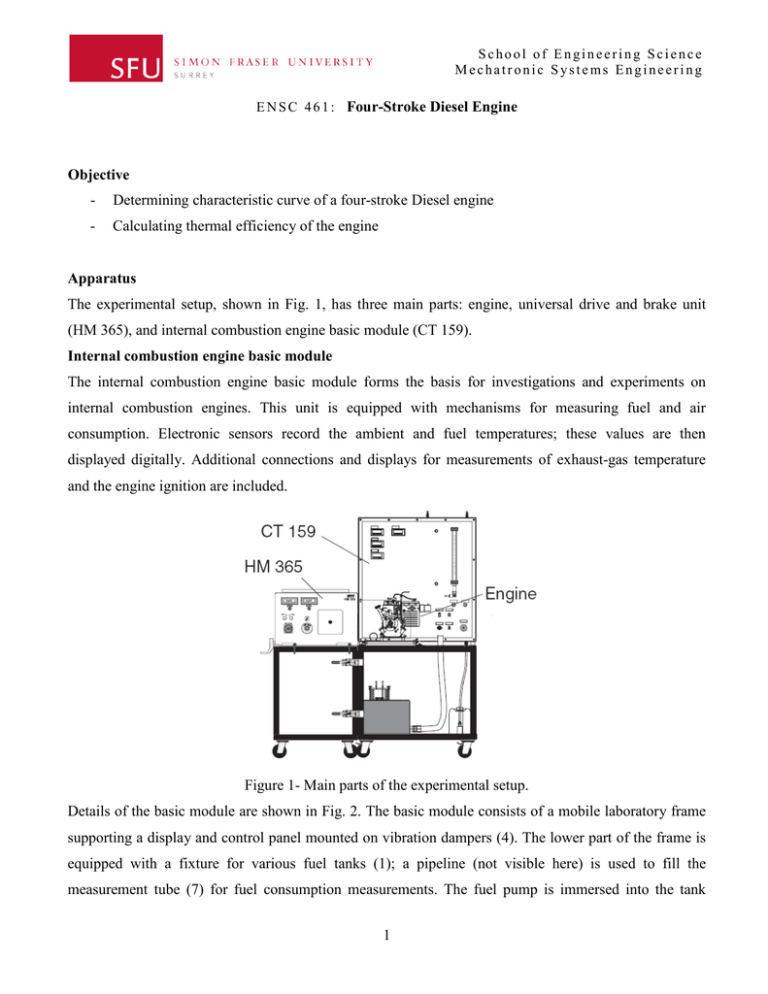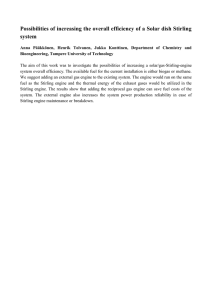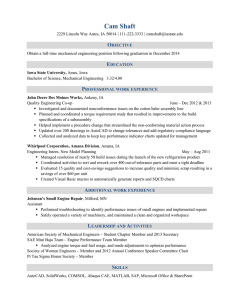S c h o o l o f ... M e c h a t r o n i...
advertisement

School of Engineering Science Mechatronic Systems Engineering E N S C 4 6 1 : Four-Stroke Diesel Engine Objective - Determining characteristic curve of a four-stroke Diesel engine - Calculating thermal efficiency of the engine Apparatus The experimental setup, shown in Fig. 1, has three main parts: engine, universal drive and brake unit (HM 365), and internal combustion engine basic module (CT 159). Internal combustion engine basic module The internal combustion engine basic module forms the basis for investigations and experiments on internal combustion engines. This unit is equipped with mechanisms for measuring fuel and air consumption. Electronic sensors record the ambient and fuel temperatures; these values are then displayed digitally. Additional connections and displays for measurements of exhaust-gas temperature and the engine ignition are included. Figure 1- Main parts of the experimental setup. Details of the basic module are shown in Fig. 2. The basic module consists of a mobile laboratory frame supporting a display and control panel mounted on vibration dampers (4). The lower part of the frame is equipped with a fixture for various fuel tanks (1); a pipeline (not visible here) is used to fill the measurement tube (7) for fuel consumption measurements. The fuel pump is immersed into the tank 1 School of Engineering Science Mechatronic Systems Engineering E N S C 4 6 1 : Four-Stroke Diesel Engine containing the fuel specified for the engine being used. A hose (2) connects the fuel tank and pipeline. The measurement tube is filled by means of a standard fuel pump. Fuel consumption can be measured manually and electronically. After the filling process, the fuel can be fed to the engine via a connection with a self-locking coupling (13); a second connection (8) is provided for engines with a return line. The engine is mounted on a ready-to-install base plate which is inserted into a seat and fastened in place. The air drawn in by the engine first flows through a filter (15) and then through a settling tank with a measuring aperture (16). After that, it flows via an air hose (3) to the engine. Electronic sensors measure the temperatures of the incoming air and fuel. Figure 2- Details of the basic module. The measurement tube is used for measuring fuel consumption. The fuel consumption is determined using a stopwatch. The consumption corresponding to time difference, ∆𝑡, can be calculated using the following equation: 𝑚̇𝑓 = (𝐿1 − 𝐿2 ) . 𝐴𝑅 . 𝜌 , ∆𝑡 𝐴𝑅 = 4.8 𝑐𝑚2 2 (1) School of Engineering Science Mechatronic Systems Engineering E N S C 4 6 1 : Four-Stroke Diesel Engine where 𝑚̇𝑓 is the fuel consumption, 𝐿1 and 𝐿2 are the filling levels in millimeters, 𝜌 is fuel density and 𝐴𝑅 is the the cross sectional area. The measurement tube is also equipped with an electronic pressure sensor for PC data acquisition. This sensor measures the hydrostatic pressure of the liquid column. The air first passes through an air filter and then through a measuring aperture into a settling tank. The measuring aperture is connected via hoses to an electronic differential pressure sensor. This sensor outputs a voltage signal which is proportional to the differential pressure, converted into volumetric flow and then indicated directly in 𝑙/𝑚𝑖𝑛. All electronically measured values are also available for transmission to a PC. Universal drive and brake unit The universal brake and drive unit provide required load for the experiment. The unit essentially comprises a three-phase motor that is actuated by a four quadrant controller. The motor makes it possible to measure the torque directly. For this purpose the motor housing is mounted in rotating bearings. An electronic force sensor measures the supporting force, which is proportional to the torque. The motor torque is calculated using the lever arm at the sensor contact point. Power is transmitted between the drive unit and the engine using a V-belt. On the front panel, shown in Fig. 3, there are two digital displays for speed (1) and torque (3). Below the displays, potentiometers are fitted for the speed (2) and torque setting (4). The switch (6) is used to specify the required direction of rotation and the "Control" changeover switch (7) is used to set the required variable (speed or torque). The three-phase motor is turned on and off using the switch (9). The master switch (5) and emergency stop switch (8) complete the controls. Figure 3- Front panel of the unit. 3 School of Engineering Science Mechatronic Systems Engineering E N S C 4 6 1 : Four-Stroke Diesel Engine Four-stroke engine The engine is an air-cooled one-cylinder 4-stroke Diesel engine. Front and side views of the engine are shown in Fig. 4a and b, respectively. The engine is mounted on a base plate (1) which is installed in the seat of the internal combustion engine basic module. The speed of the engine is set with a controller (11). To measure the exhaust temperature, the engine is equipped with a temperature sensor (6), which is installed in the area of the exhaust muffler (7). The connection (8) for the exhaust hose is also located at the exhaust muffler. (a) 1 2 3 4 5 6 7 (b) Base Unit Crank case Vibration attenuator Output shaft Flywheel cover Temperature sensor Exhaust muffler 8 9 10 11 12 13 14 Exhaust connection Air filter housing Air hose connection Speed controller Pulley Speed controller Stop magnet 15 16 17 18 19 20 21 Figure 4- a) Front b) side view of the engine. 4 Temperature sensor plug Power supply stop magnet Fuel line Return line Recoil starter Oil filling connection Oil discharge screw School of Engineering Science Mechatronic Systems Engineering E N S C 4 6 1 : Four-Stroke Diesel Engine The engine can be started with a recoil starter (19). A pulley (12) is mounted on the output shaft of the engine (4), which is used to couple the engine to the dynamometer in the brake unit. Software There are five buttons on the main program window: System diagram button displays all measured values; charts button displays recorded measurement curves; characteristic curve; About GUNT button enables one to set the language and general information and exit button is used to quit the program. The system diagram module, shown in Fig. 5, displays a function and flow diagram representing the system’s configuration. Currently measured values are indicated at the corresponding points. The fuel consumption is also indicated here. The program uses an internal time base to calculate the fuel consumption. For this purpose, the user must first select a time interval in a corresponding dialog. This interval can be 10, 20, 40 or 60 seconds. Correct consumption values are only indicated after the measurement time has elapsed. Figure 5- System diagram window. The charts window displays a time chart of the type commonly used in technical applications. All available measurement values are displayed in the lower part. The corresponding time characteristics are also displayed. Scaling of an axis can be changed by double-clicking on its final value and overwriting it with a new number. The characteristic curve module is used to record and save engine characteristics. The module functions similar to a recorder whose 𝑥 and 𝑦 axes can be freely assigned. This makes it possible to select different representations in addition to typical engine characteristics. 5 School of Engineering Science Mechatronic Systems Engineering E N S C 4 6 1 : Four-Stroke Diesel Engine Selections are made with the “Choose axis” button for assigning axes to parameters to be displayed. The scaling of an axis can be changed by double-clicking on its final value and overwriting it with a new number. A maximum of 4 recorded curves can be displayed at a time. Theory The Diesel cycle is the working cycle of compression ignition engines. Fuel is sprayed into the cylinder at 𝑝2 (high pressure) when the compression is complete, and there is an ignition without any sparks. Figure 6 shows 𝑝 − 𝑣 and 𝑇 − 𝑠 diagram for the ideal Diesel cycle; where 𝑝 is pressure, 𝑣 is the specific volume 𝑇 is the absolute temperature and 𝑠 is the entropy. The ideal Diesel cycle follows the following four distinct processes: • Process 1 to 2 is isentropic compression • Process 2 to 3 is reversible constant pressure heating • Process 3 to 4 is isentropic expansion • Process 4 to 1 is reversible constant volume cooling Figure 6- 𝑝 − 𝑣 and 𝑇 − 𝑠 diagrams for ideal Diesel cycle. Using the first law of thermodynamics, one can calculate heat addition during the process 2 to 3, 𝑞𝐻 , and heat transfer to the ambient during process 4 to 1, 𝑞𝐿 : 𝑞𝐻 = ℎ3 − ℎ2 = 𝐶𝑝 (𝑇3 − 𝑇2 ) 6 (2) School of Engineering Science Mechatronic Systems Engineering E N S C 4 6 1 : Four-Stroke Diesel Engine 𝑞𝐿 = 𝑢1 − 𝑢4 = 𝐶𝑣 (𝑇4 − 𝑇1 ) (3) 𝑤 = 𝑞𝐻 − 𝑞𝐿 = 𝐶𝑝 (𝑇3 − 𝑇2 ) − 𝐶𝑣 (𝑇4 − 𝑇1 ) (4) Subsequently, the net work done by the piston will be: Thermal efficiency of the cycle is defined as: 𝑤 𝐶𝑣 (𝑇4 − 𝑇1 ) =1− 𝑞𝐻 𝐶𝑝 (𝑇3 − 𝑇2 ) (5) 𝛼𝛾 − 1 = 1 − 𝛾−1 � � 𝑟 𝛾(𝛼 − 1) (6) 𝜂𝑡ℎ = Introducing the cut-off ratio as 𝛼 = 𝑣3 /𝑣2 and the compression ratio as 𝑟 = 𝑣1 /𝑣2 , one can rewrite Eq. (5) as: 𝜂𝑡ℎ 1 where 𝛾 = 𝐶𝑝 /𝐶𝑣 . Other important parameter in analyzing internal combustion engines is mean effective pressure (𝑚𝑒𝑝): 𝑚𝑒𝑝 = 𝑤 𝑣1 − 𝑣2 (7) In the real cycle, the characteristic of an engine is the result of the measured values determined on a test rig at various speeds for power output, 𝑃, torque, 𝑀𝑑 , and specific fuel consumption, 𝑏𝑒 . Entering these measured values on a diagram versus the speed results in the characteristic curves of the engine created by the curve of the measured points. However, a distinction should be made between full load and partial load curves. Full load is defined as the stress that an engine can overcome without a reduction in speed. In full load, the engine is braked on a test rig at operating temperature and with fully activated injection pump using a braking device. In this case the largest possible quantity of fuel is made available. The values determined over the entire speed range under different loads are the basis for the curve progression of torque, output and specific fuel consumption. Since an engine in daily use is rarely under full load, measurements under partial load are as important. Several measurements should be carried out at constant speed and under various loads of the engine. The availability of a sufficient amount of data makes it possible to establish performance characteristics for the engine. The power output can be calculated from the following equation: 7 School of Engineering Science Mechatronic Systems Engineering E N S C 4 6 1 : Four-Stroke Diesel Engine 𝑃 = 2𝜋𝑛𝑀𝑑 (8) where 𝑛 is the engine speed in rpm. The specific fuel consumption is also an important parameter that is the ratio of fuel consumption and the power output: 𝑏𝑒 = 𝑚̇𝑓 𝑃 (9) Thermal efficiency of the real cycle is calculated as: 𝜂𝑡ℎ = 𝑃 𝑃 = 𝑄𝐻 𝑚̇𝑓 ℎrp (10) where ℎrp is the reaction enthalpy of the fuel. Procedure To start the engine, the rotational direction at the HM 365 unit must be set to left, but the electric motor must be switched off. The speed adjuster of HM 365 is set to a starting speed of approximately 2000 rpm (6.66). The torque is set for both directions to 100% (10.0). As shown in Fig. 7, the speed controller at the engine then should be set to start position (start means the maximum fuel injection). The electric motor should be switched on and the Diesel engine is started. After ignition of the engine it is turning at 2000 1/min with full load. For warming up of the engine, the electric motor should be switched off. The engine then turns up to maximum speed and it must be throttled by the speed controller down to 2000 2500 rpm. Figure 7- Speed controller positions on the engine. 8 School of Engineering Science Mechatronic Systems Engineering E N S C 4 6 1 : Four-Stroke Diesel Engine For recording an output curve at full load, the speed is given by the electric motor of HM 365. The torque is generated by the combustion engine. The torque adjuster of the brake unit and the speed controller of the engine are set to maximum (100%). To record the output curve that corresponds to the full load curves, the speed controller is set to the maximum fuel quantity (start position). The potentiometer for the specified torque must be set to maximum. By gradually reducing the speed at the potentiometer, the torque values will be displayed on the universal brake unit. This can be used to form the output curve and fill Table 1. If the combustion engine is powered by the HM365 without ignition or fuel supply, it is possible to determine the friction power of the engine. The corresponding negative torque values are shown on the HM 365 unit. Table 1: Required data for calculating the full load performance curves. 𝑛 ( 𝑟𝑝𝑚) 𝑀𝑑 (𝑁𝑚) 𝑃 (𝑊) 𝑚̇𝑓 𝑇𝑎𝑖𝑟 at 𝑇𝑎𝑖𝑟 inlet exhaust at 𝑚̇𝑎𝑖𝑟 𝑇𝑓𝑢𝑒𝑙 𝑀𝑑,𝑓𝑟𝑖𝑐𝑡𝑖𝑜𝑛 (𝑁𝑚) Using the measured data, plot characteristic curves of the engine, i.e., 𝑃 - 𝑛, 𝑀𝑑 - 𝑛, 𝑀𝑑,𝑓𝑟𝑖𝑐𝑡𝑖𝑜𝑛 - 𝑛, 𝑚̇𝑓 - 𝑛 curves. Calculate thermal efficiency and mean effective pressure of the engine. Calculate the heat transfer rate to ambient; this does not include the heat transfer rate from the exhaust. To record the consumption curve, the speed of the engine should be set at the power brake of the brake unit, while the load on the engine remains at 0 (potentiometer-torque at 0). Then, the load of the engine should be increased at the potentiometer for the specified torque, slowly and gradually in equal steps, while the speed is kept constant (i.e. is adjusted at the engine). 9 School of Engineering Science Mechatronic Systems Engineering E N S C 4 6 1 : Four-Stroke Diesel Engine Table 2: Required data for calculating the partial load performance curves. 𝑛 ( 𝑟𝑝𝑚) 𝑀𝑑 (𝑁𝑚) 𝑚̇𝑓 Plot 𝑚̇𝑓 - 𝑛 curve. Discussion 1) Why is the thermal efficiency of the auto cycle higher than Diesel engine? What is the reason for increasing use of Diesel cycle instead of Otto cycle? 2) Can the Carnot cycle be used in internal combustion engines? 10




